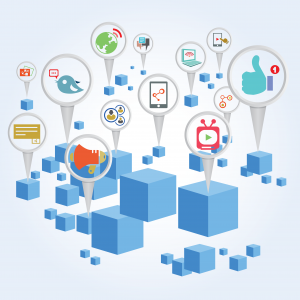What is big data anyway and why should companies really care? Data is created in a number of ways. Customers are interacting through smartphones, making purchases, carrying out online transactions, engaging on social media, and doing countless other things which generates data of great value to companies. These smaller interactions when carefully converged and correlated can convert data into useful information based on which future business strategies can be formed. The amount of data that we are sitting on right now is enormous. Companies all over the world are still finding out ways to use this data to their advantage in the best possible manner. Big IT companies are working on technologies which would garner enough computing power to be able decipher all this data, which is ever increasing at the speed of light. When it comes to the debate of using Big Data, a lot of companies are still under the impression that this data is of no use. Well, things have been changing very fast. Development of new tools, availability of better technologies and the ever increasing quest to find more about consumer behavior, are all factors which have paved way for converting available data into actionable information.
A white paper published by Ericsson in August 2013 unveiled startlin g statistics about data. The paper estimated a staggering 7 Zeta Bytes of data generated worldwide by the end of this year (1 Zeta Byte is equal to 1073 million Terabytes). Each smartphone will be generating 2 GB of data every month by the year 2018. The white paper also suggested ways in which “Big Data” will help businesses including:
g statistics about data. The paper estimated a staggering 7 Zeta Bytes of data generated worldwide by the end of this year (1 Zeta Byte is equal to 1073 million Terabytes). Each smartphone will be generating 2 GB of data every month by the year 2018. The white paper also suggested ways in which “Big Data” will help businesses including:
There are more interesting statistics unveiled by a research paper published by IDC (IDC provides market intelligence and advisory services to companies worldwide). According to the research paper from 2012 to 2020 the  amount of data will grow double each year reaching 40 trillion gigabytes by the year 2020. This report also shed light on how digital data is created. One noteworthy aspect is that more data has been created about some content shared online rather than the actual content itself, which includes likes, comments, and other ways of interacting. As argued earlier in the article, the amount of usable data is increasing. This research paper by IDC also suggests that the amount of useable digital data will increase from 25% to 33%. An increase in percentage of available data suggests that future technologies would be able to better tap into the data to provide us with reliable recommendations.
amount of data will grow double each year reaching 40 trillion gigabytes by the year 2020. This report also shed light on how digital data is created. One noteworthy aspect is that more data has been created about some content shared online rather than the actual content itself, which includes likes, comments, and other ways of interacting. As argued earlier in the article, the amount of usable data is increasing. This research paper by IDC also suggests that the amount of useable digital data will increase from 25% to 33%. An increase in percentage of available data suggests that future technologies would be able to better tap into the data to provide us with reliable recommendations.
A lot of data available today for free won’t be there to take advantage of in the future. Each passing year, with new revelations about the use of customer data, individuals have become weary of the ways in which their personal information might be used. Companies in the future will need to pay more and more to acquire reliable and actionable data. An online survey conducted by Ernst & Young in October 2013 revealed some important facts about the fast changing perception of individuals regarding use of data. The survey unveiled that 49% of consumers admitted that they will be less willing to share personal information in the future. Whereas, 78% of the individuals surveyed believed that companies were using their personal information for business gains. On the other hand, only 20% of business executive were worried that customers will start restricting the amount of personal information made publicly available in coming five years. And despite of the above numbers shared that a significant majority of customers were not willing to share their personal information in the future, 28% of the executives still believed that amount of free personal information available about the customers will not change. This shows a lack of preparation on the part of business executives. Similarly, when customers were asked about how the use of social media impacted their willingness to share personal data, 50% of the respondents said that by using the social media networks, they became more conscious about making their personal information publicly available.
It is believed that companies will start predicting what products or services customers will want in the future. Your company would be able to cut costs on research and development required to guarantee successful launch of a new product or service.
The ability to measure customer pain points through analyzing data would help companies revamp their customer service trainings and revisit their approach towards handling problems.
Customer satisfaction levels should be measured through careful analysis of feedback data and ways of improving customer experience should be devised accordingly by companies.
Availability of large chunks of data cannot guarantee that your organization will be able to profitably use it. The skills applied in making the data work for your company will be key. Ability to understand proper usage of statistical methods, interpretation of data, defining of metrics that can add meaning to strategic decision making and use of appropriate data analyzing models will play a pivotal role in ensuring effective use of ‘Big Data’. Figures, statistics, charts, graphs or other illustrations do not mean anything if a company does not have thinking heads capable of understanding the BIG PICTURE. Lastly, providing data literacy training to top executives will certainly help companies in understanding the value that data can add to strengthening customer-company bond.

Healthcare workers are entrusted with the great responsibility of caring for people. In order to continually offer comfort and care to people, there are certain skills that healthcare professionals need to master. Of course there are the obvious ones related...
Read More
Creative thinking is one of the most important and sought after soft skills that you need to acquire in an increasingly digital landscape of 2021 and beyond. Creative thinking skills are required in many different job roles to come up...
Read More
Sales are the backbone of any business and great salespeople are an asset for the company. Some people are naturally gifted in the art of persuasive communication and negotiation skills required to convince clients and effectively sell more. However, certain...
Read More